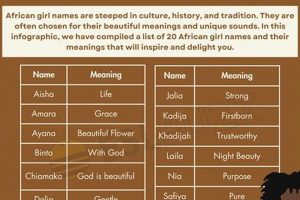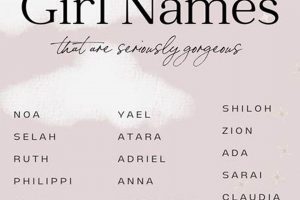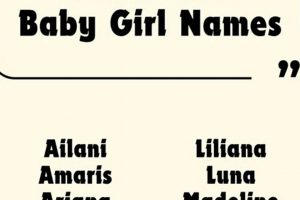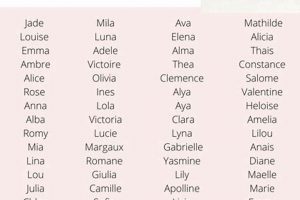Selecting appellations rooted in mythology for a female infant offers a rich tapestry of historical significance and symbolic meaning. These names often evoke qualities such as strength, beauty, wisdom, and nurturing, drawing inspiration from figures revered across diverse cultures. For example, a name like Athena, associated with Greek mythology, embodies intellect and strategic prowess.
The practice of bestowing mythological names provides a connection to ancestral narratives and imparts a sense of heritage. Such names can serve as a source of inspiration for the child, potentially influencing their character and aspirations by associating them with the virtues and attributes of the deity they are named after. Furthermore, these names are often imbued with cultural and artistic significance, resonating with individuals who appreciate history and symbolism.
The subsequent sections will explore various mythological traditions and highlight specific examples of names appropriate for a baby girl, detailing their origins, meanings, and cultural relevance. These explorations provide a framework for informed decision-making when choosing a meaningful and impactful name.
Considerations for Selecting Mythological Names
The following considerations are offered to guide the selection process of appellations for female infants, drawing inspiration from mythological traditions. These insights aim to ensure informed and meaningful choices.
Tip 1: Research the Etymology. Investigate the origins and meanings of potential names within their respective mythologies. A thorough understanding of the name’s historical context is crucial. For example, Freya, from Norse mythology, signifies “lady” and connects to love, beauty, and fertility.
Tip 2: Evaluate Cultural Significance. Assess the cultural importance of the name and its associated deity. Some names carry considerable weight and may resonate strongly within specific communities. Consider the potential impact on the child’s cultural identity.
Tip 3: Pronunciation and Spelling. Prioritize names with clear and easily pronounceable forms. Complex spellings can lead to misinterpretations and potential difficulties for the child. Simplicity enhances accessibility and recognition.
Tip 4: Consider Symbolic Associations. Reflect on the attributes and characteristics associated with the mythological figure. Ensure that these qualities align with the values and aspirations desired for the child. A name should embody positive and empowering traits.
Tip 5: Family and Personal Resonance. Discuss potential names with family members, considering their perspectives and preferences. Ultimately, the chosen name should hold personal significance and resonate deeply with the parents.
Tip 6: Avoid Cultural Appropriation. Exercise caution and sensitivity when considering names from cultures outside of one’s own. Research the potential for cultural appropriation and strive to choose names that are respectful and appropriate.
Tip 7: Shortenings and Nicknames. Contemplate possible shortenings or nicknames that could arise from the chosen name. Ensure that these alternative forms are also acceptable and desirable. Flexibility in usage provides options for various social contexts.
The careful application of these considerations will enhance the likelihood of selecting a name that is both meaningful and well-suited for the child. It will provide a strong foundation to last a lifetime.
With a foundational understanding of choosing a significant name, the article will conclude by discussing other topics.
1. Mythological origins
The selection of a appellation rooted in mythology is directly influenced by its mythological origins. These origins dictate the name’s inherent meaning, its cultural connotations, and its associated attributes. The mythological narrative surrounding a specific deity or figure informs the symbolic weight carried by the appellation. For example, the name “Diana,” derived from Roman mythology, inherently connects the individual to the goddess of the hunt, wilderness, and the moon, imbuing the name with associations of independence, strength, and connection to nature. Consequently, understanding these origins is paramount in appreciating the full significance of the appellation.
Considerations of mythological origins extend beyond simple definitions. The cultural context in which a myth arises shapes its interpretation and its relevance. A name like “Isis,” originating from Egyptian mythology, carries deep historical and religious significance within that culture. Choosing such a name requires sensitivity and awareness of its specific cultural weight. Ignoring the mythological origins can lead to misunderstandings or misinterpretations of the individual’s identity and personal associations. Researching the related story of the deity will allow the parents to select a fitting choice.
In summary, appreciating the mythological origins of a name is crucial for understanding its inherent meaning, cultural significance, and potential impact on the individual. The origins inform the selection process, ensuring that the chosen name reflects the values, aspirations, and cultural connections desired by the parents. Failing to consider these origins can result in a disconnect between the appellation and the desired identity, highlighting the importance of diligent research and thoughtful consideration.
2. Cultural Significance
The cultural significance of a appellation from mythology transcends mere etymology; it embodies a complex interplay of historical context, societal values, and symbolic representation. Appellations originating from ancient mythologies are often deeply intertwined with the traditions, beliefs, and artistic expressions of their respective cultures. Thus, choosing such a name necessitates a careful consideration of its cultural implications.
- Representation of Societal Values
Mythological figures often embody the ideals and values of their society. Selecting a name associated with a specific deity reflects a desire to imbue the child with those qualities. For instance, choosing a Celtic name may reflect a connection to heritage and cultural identity. Conversely, inappropriate or uninformed use of appellations from cultures different from one’s own can be viewed as cultural appropriation, thus lacking the intended understanding.
- Historical and Literary References
Many mythological appellations are prominently featured in literature, art, and historical narratives. These references contribute to the name’s overall cultural weight and can evoke strong associations within the minds of individuals familiar with the source material. Consideration of these references ensures that the chosen name resonates positively and avoids unintended negative associations. The impact of the Iliad on Western culture, as an example, leads to recognition and association of names such as “Helen” or “Penelope.”
- Religious and Spiritual Connotations
Some mythological figures hold religious or spiritual significance within their respective cultures. Bestowing a name associated with such a figure requires sensitivity to the potential religious implications. The name should be approached with respect and awareness of the cultural context to avoid causing offense or misrepresenting the individual’s beliefs. For example, names stemming from Shinto beliefs should be chosen with awareness from the story it comes from.
In conclusion, acknowledging the cultural significance of a specific appellation is essential for ensuring that the choice is both meaningful and respectful. A thorough understanding of the name’s historical context, societal values, and symbolic representation enables parents to make an informed decision that honors the cultural heritage associated with the moniker while simultaneously reflecting their aspirations for their child.
3. Name Meaning
The denotation inherent in a appellation is a foundational aspect when considering choices for a female infant. With mythological sources, these denotations acquire added dimensions due to their association with deities, their attributes, and the cultural narratives they represent.
- Reflecting Desired Attributes
The denotation serves as a direct representation of desired characteristics for the child. For example, “Sophia,” meaning wisdom, implies the wish that the child embody this trait. Selecting a name with a specific denotation reflects the parents’ aspirations and values. These intentions are a symbol of what they wish for their daughter to grow into.
- Cultural and Historical Context
The denotation is often intertwined with the cultural and historical significance of the mythological figure. The understanding of the name’s background allows for a comprehensive appreciation of its implications. For instance, “Artemis,” meaning “butcher” or “safe,” is associated with the Greek goddess of the hunt and wilderness. This name carries associations of independence, skill, and a connection to nature.
- Potential Influence on Identity
It is posited that a names denotation can subtly influence the individual’s self-perception and identity. A name imbued with strength and resilience, such as “Bellona” (Roman goddess of war), may encourage the child to develop such qualities. Subconscious influence of a name’s associations is thought to be a contributing factor.
- Symbolic Representation
Name denotations frequently act as symbolic representations of broader concepts. “Aurora,” Latin for “dawn,” signifies new beginnings, hope, and beauty. Such a name embodies a positive outlook and symbolizes the potential for a bright future. As names are a defining feature of a human being, that makes them representative of everything.
In summary, the denotation embedded within each appellation is a critical factor when exploring those drawn from mythology. Understanding the background allows for informed choices that reflect specific attributes, cultural connections, and symbolic representations. The informed choice is meaningful to both the parents and the future child.
4. Pronunciation Ease
The selection of a moniker with facility of articulation is a pragmatic consideration in conjunction with the aesthetic and symbolic appeal of appellations derived from mythological sources. The ease with which a name can be pronounced directly impacts its social acceptance and reduces the likelihood of misinterpretations or misspellings.
- Social Integration
An easily pronounced name promotes seamless social integration. Individuals are more likely to use the name confidently and correctly, fostering positive interactions. Complex or unfamiliar pronunciations can lead to hesitation, mispronunciations, and potential embarrassment for the individual and those addressing them. The impact on self-esteem should be considered, as well as the annoyance others may feel for constantly having to correct name mispronunciations.
- Global Accessibility
In an increasingly interconnected world, a name’s global accessibility is significant. A name that is easily pronounced across different languages and cultures enhances communication and reduces barriers. Names with sounds specific to certain languages may present challenges for individuals unfamiliar with those sounds. Cultural sensitivity is critical in name selection. Those within that cultural group may face discrimination or not be taken seriously if they do not pronounce the name as it should be.
- Reduced Administrative Errors
Names with straightforward pronunciations are less prone to errors in official documents and administrative processes. Misspellings and inaccuracies can lead to complications in legal, medical, and educational contexts. A name’s simplicity contributes to efficiency and accuracy in record-keeping.
- Cognitive Processing
Easily articulated names require less cognitive effort to process and remember. Individuals are more likely to recall and use the name accurately, strengthening social connections. Complex names can strain cognitive resources and impede clear communication. Easy to pronounce names ensure clarity when addressing the individual.
In conclusion, while the symbolic resonance and cultural significance of mythological names are valuable, it is crucial to consider pronunciation ease to ensure positive social interactions, global accessibility, and administrative accuracy. A balanced approach considering both the aesthetic and pragmatic aspects is recommended when selecting appellations for a female infant.
5. Symbolic association
The act of selecting a “goddess names for baby girl” inherently involves engaging with symbolic association. Each figure from mythology carries a complex tapestry of attributes, virtues, and narrative experiences, forming a symbolic representation that the name subsequently invokes. The decision to bestow a particular name, therefore, signifies an intent to align the child with the qualities and characteristics associated with that mythological figure. The ramifications of such an alignment can extend to societal perceptions, personal aspirations, and even self-identity. For instance, choosing the moniker “Athena” directly links the child to the Greek goddess of wisdom, strategy, and craftsmanship. This association can consciously or subconsciously influence both the child’s self-perception and the expectations others hold for her academic or intellectual pursuits.
Practical applications of understanding this connection lie in making informed and meaningful choices. Parents considering “goddess names for baby girl” should delve beyond superficial aesthetics and research the symbolic significance attached to each potential name. Examining the associated myths, virtues, and historical context allows for a nuanced comprehension of the impact such a name might have. For example, selecting “Freya,” the Norse goddess of love, beauty, and fertility, could be a deliberate choice to emphasize these attributes in the child’s life. This deliberate approach contrasts sharply with a decision based solely on phonetic appeal, which risks overlooking potentially contradictory or undesirable associations. By understanding the specific symbolism, parents can avoid imposing unintended burdens or conflicting expectations upon their child.
In summary, the link between symbolic association and “goddess names for baby girl” is critical for responsible and meaningful name selection. Challenges arise when individuals are unaware of or disregard the significance of these associations, leading to choices that are ultimately incongruent with their values or aspirations. Recognizing the power of symbolic association allows for a purposeful alignment between name, identity, and desired qualities, fostering a sense of connection to cultural heritage and personal ideals. The selection process should be conducted with thoughtful intention, acknowledging the lasting impact a name can have on an individual’s life.
6. Family Resonance
The selection of “goddess names for baby girl” is inextricably linked to the concept of family resonance. This term encompasses the collective agreement, historical ties, and shared values within a family unit, which significantly influences the decision-making process regarding names. The degree to which a mythological name harmonizes with these elements determines its suitability.
- Ancestral Connections
Many families maintain lineages with specific cultural or national origins. Selecting “goddess names for baby girl” that reflect these ancestral roots can strengthen familial bonds and reinforce a sense of identity. For example, if a family has strong ties to Irish heritage, choosing a name from Celtic mythology would be a fitting tribute. Such a choice can serve as a constant reminder of shared history and cultural heritage, deepening connections between generations.
- Shared Values and Beliefs
Families often hold core values and beliefs that guide their decisions. The choice of “goddess names for baby girl” can reflect these values. A family prioritizing intellectual pursuits might favor a name associated with wisdom or knowledge, such as Athena. Conversely, a family emphasizing nurturing and compassion might select a name related to motherhood or protection. These choices indicate alignment with the family’s moral compass and impart these values to the child.
- Acceptance and Agreement
The final selection requires acceptance and agreement among family members, particularly parents and sometimes grandparents. Disagreements over name choices can create tension and discord. Reaching a consensus ensures that the chosen name is embraced and celebrated by all, fostering a supportive environment for the child. Compromise and open communication are essential for navigating differing opinions and finding a name that resonates positively with everyone involved.
- Existing Family Names and Traditions
Families frequently have established naming traditions, such as honoring deceased relatives or using names with specific numerical significance. The selection of “goddess names for baby girl” must consider these traditions to maintain continuity and respect for past generations. For example, if a family historically uses middle names from mythology, the selection of a first name must complement this tradition. Adherence to established patterns can strengthen familial connections and create a sense of belonging.
In conclusion, family resonance plays a vital role in the selection process of “goddess names for baby girl.” The degree to which a name aligns with ancestral connections, shared values, familial agreement, and existing traditions determines its suitability and potential to foster a sense of belonging and continuity. A thoughtful consideration of these elements leads to a name that not only reflects the family’s identity but also honors its history and strengthens its bonds.
7. Appropriateness
The concept of appropriateness is paramount when considering “goddess names for baby girl.” A potential appellation’s alignment with cultural context, family background, and societal norms directly impacts its suitability and the child’s future social interactions. Selecting a name that is considered inappropriate can lead to negative consequences, including misinterpretations, cultural insensitivity, and potential social challenges for the child. For example, choosing a name from a culture with which the family has no connection or understanding can be viewed as cultural appropriation, causing offense and undermining the name’s intended meaning.
Practical applications of this understanding involve thorough research and thoughtful consideration. Prospective parents should investigate the origins, meanings, and cultural significance of potential “goddess names for baby girl.” This investigation includes understanding any potential negative connotations or historical baggage associated with the name. Furthermore, open communication with family members and cultural advisors can provide valuable insights into the name’s appropriateness within the specific context. Consider the ease of pronunciation and potential for misinterpretation within the family’s social circle. Names carrying significant religious or spiritual weight require careful consideration to avoid causing offense or misrepresenting the child’s beliefs.
In conclusion, appropriateness serves as a critical filter in the selection process of “goddess names for baby girl.” Overlooking this aspect can result in unintended negative consequences, undermining the name’s intended beauty and significance. Prioritizing cultural sensitivity, familial harmony, and societal norms ensures that the chosen name is not only meaningful but also appropriate, fostering a positive and supportive environment for the child’s development. The careful consideration of appropriateness ensures the name chosen has the best possible start to a successful and happy life.
Frequently Asked Questions About “goddess names for baby girl”
The following section addresses common inquiries and misconceptions surrounding the selection of appellations for female infants derived from mythological sources.
Question 1: What are the primary considerations when selecting “goddess names for baby girl” that avoid cultural appropriation?
Due diligence mandates thorough research into the name’s origins, cultural context, and potential for misuse. Choosing appellations from cultures without familial or personal connection requires sensitivity and respect. Consultation with cultural experts is advisable.
Question 2: How significant is the etymological denotation of “goddess names for baby girl” compared to its sound or aesthetic appeal?
The etymological denotation carries significant weight, as it reflects the inherent meaning and symbolic associations of the name. A comprehensive selection process prioritizes both the denotation and the aesthetic appeal to ensure a meaningful and pleasing appellation.
Question 3: What steps should be taken to ensure that the chosen “goddess names for baby girl” is easily pronounceable and recognizable across diverse cultural backgrounds?
Choosing appellations with straightforward phonetic structures minimizes mispronunciations and enhances global accessibility. Verification with individuals from various linguistic backgrounds can identify potential challenges. Practical testing among a sample group is beneficial.
Question 4: How can potential negative connotations associated with specific “goddess names for baby girl” be effectively mitigated?
Comprehensive research into the mythological figure’s narrative and associated symbolism is crucial. Appellations with ambiguous or unfavorable connotations may be unsuitable, necessitating alternative choices with more positive associations. Understanding and openly acknowledging potential downsides is wise.
Question 5: To what extent should familial preferences and traditions influence the selection of “goddess names for baby girl,” especially when differing opinions arise?
While familial preferences hold considerable importance, the final decision should prioritize the child’s well-being and future social interactions. Open communication and compromise are essential for navigating differing opinions and ensuring that the chosen appellation receives widespread support.
Question 6: How can the long-term implications of selecting an uncommon or unconventional “goddess names for baby girl” be assessed and prepared for?
Consideration should be given to potential challenges such as frequent misspellings, mispronunciations, and the need for constant explanations. Providing the child with a clear understanding of the appellation’s origins and significance can empower them to navigate these challenges confidently.
In summary, careful consideration of etymology, pronunciation, cultural sensitivity, familial preferences, and potential implications is paramount when selecting a mythological name. These considerations will help lead to a well-informed decision that provides lasting benefits.
The subsequent section will delve into further strategies for choosing the perfect name.
Conclusion
The exploration of “goddess names for baby girl” has underscored the multifaceted considerations inherent in selecting such appellations. The influence of mythological origins, cultural significance, denotation, pronunciation ease, symbolic associations, familial resonance, and appropriateness has been examined. This examination reveals that the selection process transcends superficial preferences, demanding a comprehensive understanding of the name’s inherent qualities and potential impact.
Ultimately, the deliberate application of these principles can lead to a meaningful selection, imbuing the child with a sense of identity rooted in history and cultural narrative. May the selected name serve as a source of inspiration and strength, reflecting both familial values and the enduring power of mythological archetypes.







